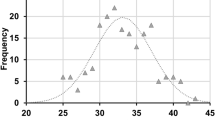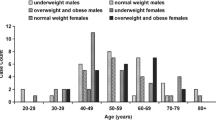Abstract
Background
A reliable method for direct measurement of both subcutaneous and visceral fat volume is the measurement of fat tissue area from tomographic pictures by CT or by MR imaging. However, these are not widely usable because of high cost and/or exposure to radiation.
Methods
We compared sonographic subcutaneous and visceral fat indices with fat distribution by serial-slice MR imaging in 17 subjects. Sonographic subcutaneous or visceral fat index is standardized thickness of subcutaneous fat tissue or the intra-abdominal depth at the level of umbilicus by height.
Results
Sonographic visceral fat index and intra-abdominal depth were significantly correlated with visceral fat volume by serial-slice MR imaging (r = 0.746, r = 0.726, respectively). Similarly, sonographic subcutaneous fat index and subcutaneous fat thickness were significantly correlated with subcutaneous fat volume by serial-slice MR imaging (r = 0.825, r = 0.816, respectively). The ratio of sonographic visceral fat index and sonographic subcutaneous fat index was closely correlated with the ratio of the visceral fat volume and the subcutaneous fat volume by single-slice MR imaging, which proves to be related to cardiovascular disease risk (r = 0.722).
Conclusion
Sonographic subcutaneous or visceral fat index could be an easily measured and inexpensive indicator for the assessment of fat distribution instead of CT or MR imaging.




Similar content being viewed by others
References
Kissebah AH, Vydelingum N, Murray R, et al. (1982) Relation of body fat distribution to metabolic complications of obesity. J Clin Endocrinol Metab 54:254–260
Kalkhoff RK, Hartz AH, Rupley D, et al. (1983) Relationship of body fat distribution to blood pressure, carbohydrate tolerance, and plasma lipids in healthy obese women. J Lab Clin Med 102:621–627
Larsson B, Svardsudd K, Welin L, et al. (1984) Abdominal adipose tissue distribution, obesity, and risk of cardiovascular disease and death: 13 year follow up of participants in the study of men born in 1913. Br Med J 288:1401–1404
Fujioka S, Matsuzawa Y, Tokunaga K, et al. (1987) Contribution of intra-abdominal fat accumulation to the impairment of glucose and lipid metabolism in human obesity. Metabolism 36:54–59
Tokunaga K, Matsuzawa Y, Ishikawa K, et al. (1983) A novel technique for the determination of body fat by computed tomography. Int J Obes 7:437–445
Seidell JC, Bakker CJ, van der Kooy K (1990) Imaging techniques for measuring adipose-tissue distribution—a comparison between computed tomography and 1.5-T magnetic resonance. Am J Clin Nutr 51:953–957
Lancaster JL, Ghiatas AA, Alyassin A, et al. (1991) Measurement of abdominal fat with T1-weighted MR images. J Magn Reson Imaging 1:363–369
Gronemeyer SA, Steen RG, Kauffman WM, et al. (2000) Fast adipose tissue (FAT) assessment by MRI. Magn Reson Imaging 18:815–818
van der Kooy K, Leenen R, Seidell JC, et al. (1993) Waist–hip ratio is a poor predictor of changes in visceral fat. Am J Clin Nutr 57:327–333
Abe T, Kawakami Y, Sugita M, et al. (1995) Use of B-mode ultrasound for visceral fat mass evaluation: comparisons with magnetic resonance imaging. Appl Hum Sci 14:133–139
Suzuki R, Watanabe S, Hirai Y, et al. (1993) Abdominal wall fat index, estimated by ultrasonography, for assessment of the ratio of visceral fat to subcutaneous fat in the abdomen. Am J Med 95:309–314
Armellini F, Zamboni M, Robbi R, et al. (1993) Total and intra-abdominal fat measurements by ultrasound and computerized tomography. Int J Obes 17:209–214
Kushner RF, Schoeller DA (1986) Estimation of total body water by bioelectrical impedance analysis. Am J Clin Nutr 44:417–424
Lukaski HC, Bolonchuk WW, Hall CB, et al. (1986) Validation of tetrapolar bioelectrical impedance method to assess human body composition. J Appl Physiol 60:1327–1332
Sutcliffe JF (1996) A review of in vivo experimental methods to determine the composition of the human body. Phys Med Biol 41:791–833
Stansell MJ, Mojica L Jr (1968) Determination of body water content using trace levels of deuterium oxide and infrared spectrophotometry. Clin Chem 14:1112–1124
Kamba M, Meshitsuka S, Iriguchi N, et al. (2000) Measurement of relative fat content by proton magnetic resonance spectroscopy using a clinical imager. J Magn Reson Imaging 11:330–335
Borkan GA, Gerzof SG, Robbins AH, et al. (1982) Assessment of abdominal fat content by computed tomography. Am J Clin Nutr 36:172–177
Weits T, van der Beek EJ, Wedel M, et al. (1988) Computed tomography measurement of abdominal fat deposition in relation to anthropometry. Int J Obes 12:217–225
Fanelli MT, Kuczmarski RJ (1984) Ultrasound as an approach to assessing body composition. Am J Clin Nutr 39:703–709
Kuczmarski RJ, Fanelli MT, Koch GG (1987) Ultrasonic assessment of body composition in obese adults: overcoming the limitations of the skinfold caliper. Am J Clin Nutr 45:717–724
Leite CC, Wajchenberg BL, Radominski R, et al. (2002) Intra-abdominal thickness by ultrasonography to predict risk factors for cardiovascular disease and its correlation with anthropometric measurements. Metabolism 51:1034–1040
Author information
Authors and Affiliations
Corresponding author
Rights and permissions
About this article
Cite this article
Koda, M., Senda, M., Kamba, M. et al. Sonographic subcutaneous and visceral fat indices represent the distribution of body fat volume. Abdom Imaging 32, 387–392 (2007). https://doi.org/10.1007/s00261-006-9082-3
Received:
Accepted:
Published:
Issue Date:
DOI: https://doi.org/10.1007/s00261-006-9082-3




